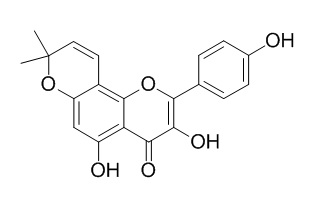Citrusinol
Citrusinol exhibits cytotoxic activities against the HepG2 cell.
Inquire / Order:
manager@chemfaces.com
Technical Inquiries:
service@chemfaces.com
Tel:
+86-27-84237783
Fax:
+86-27-84254680
Address:
1 Building, No. 83, CheCheng Rd., Wuhan Economic and Technological Development Zone, Wuhan, Hubei 430056, PRC
Providing storage is as stated on the product vial and the vial is kept tightly sealed, the product can be stored for up to
24 months(2-8C).
Wherever possible, you should prepare and use solutions on the same day. However, if you need to make up stock solutions in advance, we recommend that you store the solution as aliquots in tightly sealed vials at -20C. Generally, these will be useable for up to two weeks. Before use, and prior to opening the vial we recommend that you allow your product to equilibrate to room temperature for at least 1 hour.
Need more advice on solubility, usage and handling? Please email to: service@chemfaces.com
The packaging of the product may have turned upside down during transportation, resulting in the natural compounds adhering to the neck or cap of the vial. take the vial out of its packaging and gently shake to let the compounds fall to the bottom of the vial. for liquid products, centrifuge at 200-500 RPM to gather the liquid at the bottom of the vial. try to avoid loss or contamination during handling.
Food Chem.2020, 332:127412
Chem Biol Interact.2018, 290:44-51
Phytomedicine.2022, 102:154183.
Nutrients.2020, 12(11):3448.
Plants (Basel).2023, 12(22):3877.
Food Control2022, 132:108434.
Neurotox Res.2020, 38(1):163-174.
Environ Toxicol.2023, tox.23999.
J Ethnopharmacol.2019, 241:112025
J AOAC Int.2021, 104(6):1634-1651.
Related and Featured Products
Zhongguo Zhong Yao Za Zhi. 2008 Sep;33(18):2077-80.
Studies on constituents of rootsanel leaves from Desmodium blandum and their cytotoxic activity against growth of several tumor cells.[Pubmed:
19160788]
To investigate the chemical constituents of Desmodium blandum and their cytotoxic activity against the growth of several tumor cells.
METHODS AND RESULTS:
Various chromatographic techniques including silica gel, Sephadex LH-20 column chromatography were employed for the isolation and purification of the constituents. The structures of compounds were elucidated by spectral analyses (IR, UV, NMR, MS). Their cytotoxic activity was then studied. Eight compounds were isolated from the stems of D. blandum and identified as N, N-dimethyltryptamine (1), 5-methoxy-N, N-dimethyltryptamine (2), Citrusinol (3), yukovanol (4), (Z)-1-(4-hydroxy-2, 3-dimethoxyphenyl)-3-(4-hydroxyphenyl) propene (5), (Z)-1-(3-hydroxy-2, 4-dimethoxy-phenyl)-3-(4-hydroxy-3-methoxy-phenyl) propene (6), methylprotocatechuate (7), katuranin (8).
CONCLUSIONS:
Among these compounds, compound 6 was isolated from D. blandum for the first time. In the MTT test, compounds 2 and 6 exhibit cytotoxic activities against the KB cell, and compounds 3 and 6 exhibit the same activities against the HepG2 cell.



